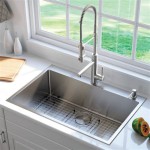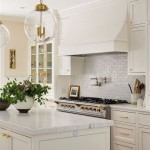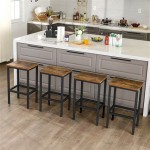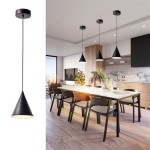The Enduring Popularity of the Kitchen Faucet With Single Handle
The kitchen faucet with a single handle represents a ubiquitous fixture in modern homes. Its prevalence stems from a combination of factors including ease of use, streamlined aesthetics, and advancements in manufacturing that have made them both durable and affordable. While various faucet designs exist, the single-handle version continues to hold a significant market share, appealing to homeowners seeking a balance of functionality and style.
This article will delve into the characteristics, advantages, disadvantages, and practical considerations associated with kitchen faucets featuring a single handle. It will explore the mechanics behind their operation, common materials used in their construction, prevalent design styles, and key factors to consider when selecting and maintaining such a faucet. The aim is to provide a comprehensive understanding of these fixtures, enabling informed decisions regarding their purchase and upkeep.
Understanding the Mechanics of Single-Handle Faucets
At the core of a single-handle kitchen faucet lies a cartridge or ceramic disc mechanism. This component is responsible for regulating the flow of both hot and cold water and controlling the overall water pressure. The single handle directly manipulates this mechanism, allowing the user to adjust both temperature and volume with a single motion. The specific design of the cartridge or ceramic disc varies between manufacturers and models, but the underlying principle remains consistent: a single point of control for water delivery.
Cartridge-based faucets utilize a plastic or metal cartridge containing rubber or synthetic seals. As the handle is moved, these seals align or misalign with openings in the valve body, thereby regulating the flow of water. Over time, these seals can degrade, leading to leaks or difficulty in controlling the water temperature. Replacing the cartridge is typically a straightforward process, often involving the removal of a retaining clip and the installation of a new cartridge.
Ceramic disc faucets, on the other hand, employ two ceramic discs that move against each other. These discs have precisely engineered openings that align to varying degrees, controlling both the water flow and temperature. Ceramic disc faucets are generally considered more durable and less prone to leaks than cartridge-based faucets due to the hardness and wear-resistance of the ceramic material. While the initial cost may be higher, the long-term reliability often makes them a worthwhile investment.
The efficiency of both cartridge and ceramic disc faucets is directly related to their design and manufacturing quality. A poorly designed or manufactured faucet, regardless of its underlying mechanism, will likely exhibit problems such as dripping, inconsistent water temperature, or difficulty in adjusting the water flow. Therefore, selecting a faucet from a reputable manufacturer with a proven track record is crucial.
Advantages and Disadvantages of Single-Handle Designs
The popularity of single-handle kitchen faucets is largely attributable to their inherent advantages. The primary benefit is their ease of use. The ability to control both water temperature and flow with a single hand is particularly convenient when one hand is occupied. This is a significant advantage in a busy kitchen environment where multitasking is common. The simplicity of operation also makes them a user-friendly choice for individuals with limited dexterity or mobility.
Furthermore, single-handle faucets often present a cleaner, more minimalist aesthetic compared to their dual-handle counterparts. The absence of separate hot and cold water handles contributes to a less cluttered appearance, which aligns well with contemporary kitchen designs. This streamlined design can also simplify cleaning, as there are fewer crevices and surfaces where dirt and grime can accumulate.
However, single-handle faucets are not without their limitations. One potential drawback is the learning curve associated with finding the desired water temperature. Unlike dual-handle faucets where the proportion of hot and cold water can be intuitively adjusted, single-handle faucets require a more deliberate movement to achieve the desired temperature. This can lead to a period of trial and error, especially for new users.
Another potential disadvantage lies in the complexity of the internal mechanism. While replacing a cartridge or ceramic disc is generally a manageable task for a DIY enthusiast, diagnosing the underlying cause of a problem can sometimes be challenging. In contrast, dual-handle faucets often have simpler internal components, making troubleshooting and repair potentially more straightforward. Replacement parts for older or less common single-handle faucet models may also be more difficult to source compared to parts for more standardized dual-handle designs.
Factors to Consider When Choosing a Single-Handle Kitchen Faucet
Selecting the appropriate single-handle kitchen faucet involves careful consideration of several factors, including material, finish, spout style, and overall design. The material used in the faucet's construction significantly impacts its durability and longevity. Brass, stainless steel, and zinc alloys are common choices, each offering different levels of corrosion resistance and strength. Brass is generally considered the most durable option, but stainless steel provides excellent corrosion resistance and a modern aesthetic. Zinc alloys are often used in more affordable faucets, but may be less resistant to wear and tear.
The faucet's finish plays a crucial role in its appearance and resistance to scratches and stains. Common finishes include chrome, brushed nickel, oil-rubbed bronze, and matte black. Chrome is a classic choice that is easy to clean and maintain, while brushed nickel offers a warmer, more subtle look. Oil-rubbed bronze provides a traditional, elegant aesthetic, while matte black is a popular choice for contemporary kitchens. The choice of finish should complement the overall design of the kitchen and be resistant to the daily wear and tear of a busy environment.
The spout style is another important consideration. High-arc spouts offer ample clearance for filling large pots and pans, while low-arc spouts provide a more streamlined look. Pull-down or pull-out spouts add versatility, allowing for easy rinsing of the sink and surrounding areas. The choice of spout style should be based on the user's specific needs and preferences, considering factors such as sink size, countertop space, and frequency of use for tasks such as washing large items.
Beyond these functional considerations, the overall design of the faucet should align with the aesthetic of the kitchen. Single-handle faucets are available in a wide range of styles, from traditional to contemporary, allowing homeowners to choose a fixture that complements their existing décor. The faucet's shape, size, and details should be carefully considered to ensure a cohesive and visually appealing look. Furthermore, features such as integrated soap dispensers or touch-activated technology can add convenience and enhance the overall user experience. Finally, compliance with water efficiency standards (e.g., WaterSense certification) should be a priority to minimize water consumption and reduce utility bills.
Proper installation is crucial for ensuring the longevity and performance of a single-handle kitchen faucet. While DIY installation is possible for those with plumbing experience, professional installation is often recommended, especially for complex installations or when replacing an existing faucet. A qualified plumber can ensure that the faucet is properly connected to the water supply, preventing leaks and other potential problems. Regular maintenance, such as cleaning the faucet with mild soap and water and checking for leaks, can also help to prolong its lifespan and maintain its appearance.

Single Handle Kitchen Faucet Brushed Nickel Finish

Single Handle Kitchen Faucet With Pull Down Sprayer 1 Hole Sink Brass Commercial Taps In Matte Black

Moen Georgene Spot Resist Stainless Single Handle Pull Down Kitchen Faucet With Sprayer Deck Plate Included 87912srs At Lowes Com

Seasons Raleigh Single Handle Pull Out Sprayer Kitchen Faucet In Chrome 67222w 1001

Kraus Kpf 2620sfs Oletto Spot Free Stainless Steel Dual Function Pull Down Kitchen Faucet

Single Handle Kitchen Faucets Lever Pfister

Single Handle Onl Wall Kitchen Faucet

Contemporary Pull Down Touch Single Handle Kitchen Faucet In Ch

Delta Grant Pullout Kitchen Faucet Stainless

P199152lf Single Handle Kitchen Faucet With Spray








